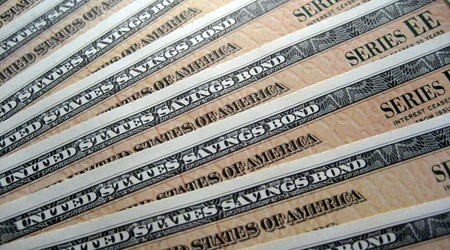How to Buy Savings Bonds

When I was growing up I loved getting presents. I could easily think of things I wanted when my parents asked around my birthday or Christmas. There was one present that I got each year that I didn't quite understand at the time. Every Christmas my grandparents gave me savings bonds. "Can I spend it?" I would ask. My mom would say, "Not yet, but someday." At the time I was confused, but now I realize how thoughtful a gift it was. I didn't need another toy to play with as I was blessed with enough already.
The savings bonds that my grandparents bought me over the years helped me in multiple ways. Not only did I get a gift that grew in value (which is more than I can say for my Micro Machines), I also learned at an early age about the time value of money principle. Eventually I used some of the money to help me buy a used car after college and I still have some of the higher interest earning savings bonds they gave me. I've even begun buying them for my nieces and nephew each year at Christmas. But enough about how great I think they are, let's get into the details.
How Savings Bonds Work
Savings bonds are issued by the U.S. federal government to an individual (either the purchaser or a designee) and grow at a set interest rate over time. The most common term length is twenty years. When a paper savings bond is purchased, half of the maturity value of it is paid and the rest is earned through interest. For example, a fifty dollar savings bond with a twenty year investment time frame would cost twenty five dollars. It would not be worth its full value until it had matured. A paper savings bond looks like a cashier's or traveler's check and has the owner's name on it as well as the date of maturity. If you purchase an electronic savings bond, you pay full face value and it is worth its full value when it is available for redemption.
Interest Rate
Depending on the kind of bond and when it was purchased, the interest rate can vary. To check the latest interest rates from the Federal Reserve, go to this website. Two main kinds of savings bonds are EE and I. EE savings bonds earn a fixed rate of return and you can always look up their current value using this handy savings bond value calculator. An I savings bond earns interest but it also protects you from inflation. It is adjusted based on how inflation changes over time.
Taxes Only at Redemption
One nice thing about savings bonds is that you don't have to claim any of the interest on the savings bonds until you redeem them. When you do cash them in you must pay federal income tax on them, but not state or local taxes. An exception to this rule is if you use the savings bonds to pay for education expenses. When used for post-secondary tuition or fees you don't have to pay taxes on the savings bonds.
Early Redemption Penalty
If a savings bond is redeemed within five years from which it was issued, there is a three-month penalty. For example, a savings bond cashed after just 48 months would only be worth the original price plus 45 months of interest.
Where to Buy Savings Bonds
The best place to purchase savings bonds is from TreasuryDirect.gov. This is the federal government's home page for treasury bills, notes, bonds and other government issued securities. You simply sign up for an account, they mail you an ID number and then you can purchase savings bonds just like you would at a bank.
Some, but not all banks allow you purchase savings bonds directly through them for both yourself and others. Before you go, make sure you have the social security number for the person you want the bond issued to though.
Another option for buying savings bonds is through your employer. Some companies allow you to purchase them directly through your paycheck. While I would recommend you invest in your 401(k) and a Roth IRA first, they are an option for long term stable growth or as a gift for someone.







